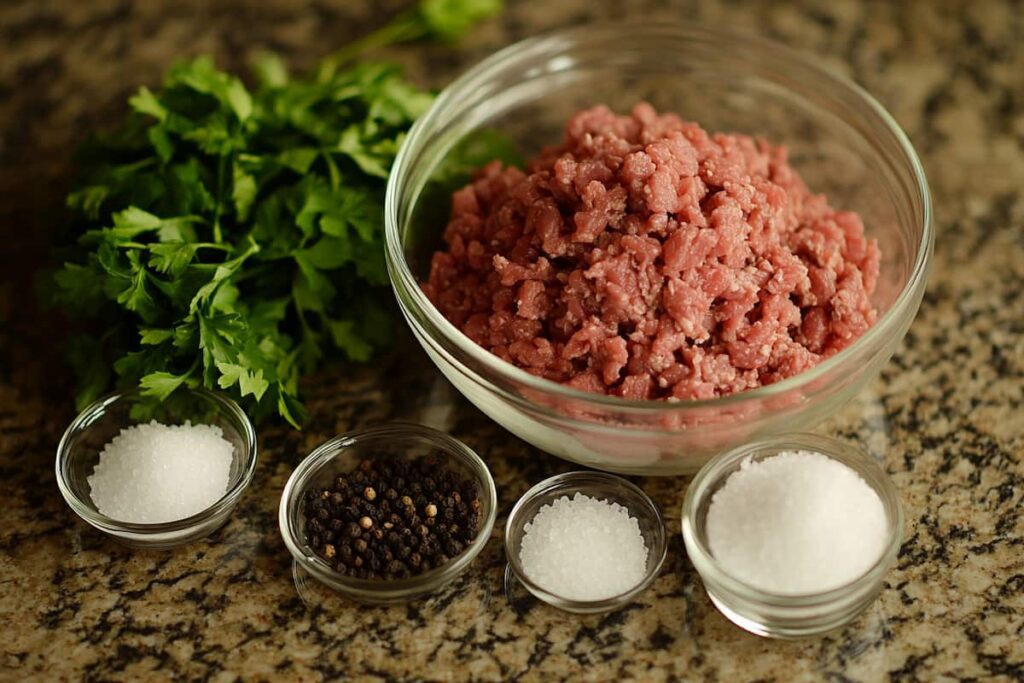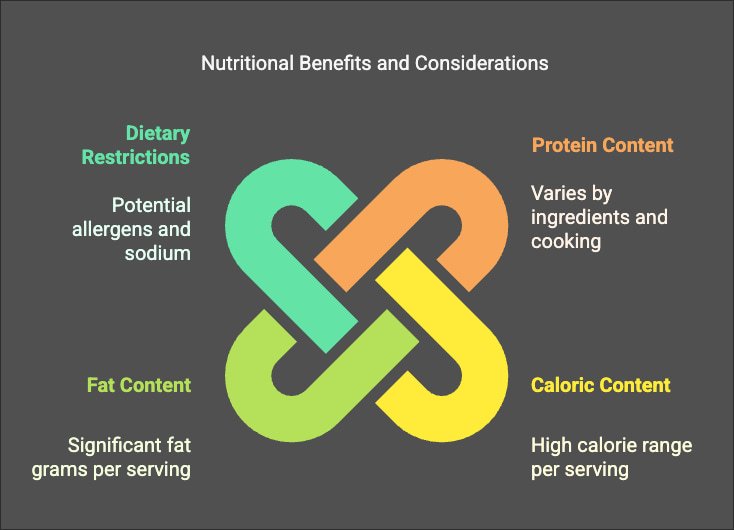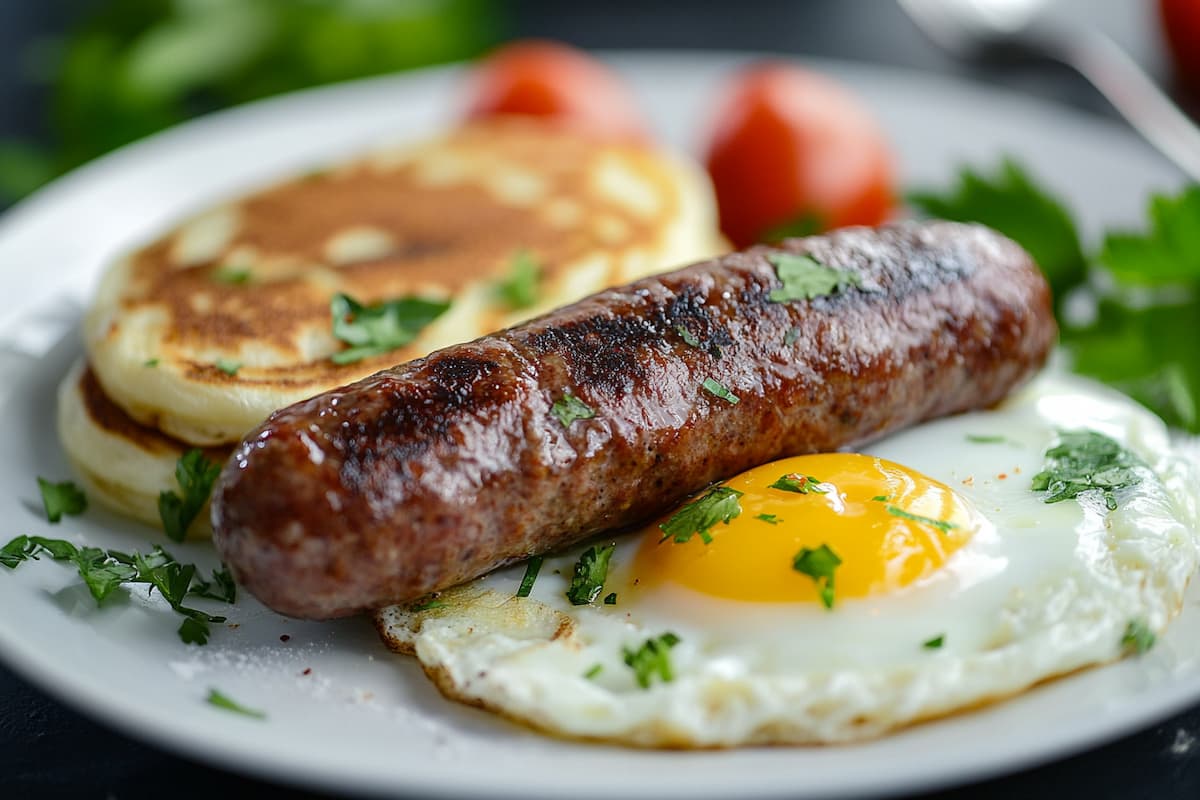Beef breakfast sausage is a popular choice for morning meals. Its savory flavor is enjoyed by many. Whether you’re looking for a hearty addition to your breakfast plate or a flavorful ingredient for recipes, this sausage can elevate your morning routine.
Is beef sausage good for breakfast?
Yes! It’s rich in flavor and provides essential nutrients to kickstart your day.
For more details, check out our in-depth article: Is Beef Sausage Good for Breakfast? Expert Nutrition Breakdown
In this recipe guide, we’ll explore everything about beef breakfast sausage. You’ll learn about its history, cultural significance, and cooking methods. We’ll also discuss essential ingredients and equipment for making delicious sausage. In addition, you’ll get tips on pairing it with other breakfast foods and condiments. Finally, you’ll be an expert on beef breakfast sausage, ready to cook it with confidence using different techniques!
Key Takeaways
- Beef breakfast sausage is a popular and versatile breakfast food
- Cooking techniques can enhance the flavor and texture of beef breakfast sausage
- Beef breakfast sausage can be part of a healthy diet when prepared and consumed in moderation
- Traditional recipes and modern variations can be used to prepare beef breakfast sausage
- Pairing beef breakfast sausage with other foods and condiments can add flavor and variety to your breakfast meal
- Understanding the history and cultural significance of beef breakfast sausage can appreciate its value and significance
Understanding Beef Breakfast Sausage
Beef breakfast sausage is a special type of sausage. It’s known for its mix of traditional ingredients and cultural importance. Knowing what makes it unique is key to truly enjoying this dish.
The ingredients in beef breakfast sausage, like ground beef and pork, give it a distinct taste. A blend of spices adds to its savory and slightly sweet flavor.
What Makes Breakfast Sausage Different from Regular Sausages
Beef breakfast sausage is special because of its cultural value. In many places, sausage is a food that brings people together. This sausage is no different, offering a warm, comforting taste perfect for breakfasts and special events.
For complete details, take a look at our detailed article What makes breakfast sausage different from regular sausage?
Beef Breakfast Sausage: Traditional Ingredients
Some common ingredients in beef breakfast sausage are:
- Ground beef
- Pork
- Spices like salt, pepper, and sage
- Herbs like parsley and thyme
Beef Breakfast Sausage: Cultural Significance
In the United States, beef breakfast sausage is a popular breakfast dish. It’s often served with eggs, pancakes, and other foods. Each region has its own sausage type, which shows the dish’s cultural importance.
Learning about beef breakfast sausage’s unique ingredients and cultural value can deepen one’s appreciation for the dish, making it even more rewarding to prepare and enjoy.
The History Behind Beef Breakfast Sausage
The history of sausage is filled with stories from around the world. It shows how different cultures have shaped our breakfasts. From ancient times to today, sausages have become a key part of our morning meals.
Some key moments in the history of sausage include:
- The ancient Greeks and Romans loved sausages as a main food.
- In medieval Europe, sausages helped preserve meat.
- Today, we enjoy sausages with eggs, toast, and more in our breakfasts.
Learning about the history of sausage and its role in breakfast traditions is fascinating. It helps us see how this food has become a big part of our mornings. By exploring how beef breakfast sausage came to be, we can appreciate the traditions that have shaped our breakfasts.
If you love food or just enjoy sausages, the story of beef breakfast sausage is captivating. Next time you have sausages and eggs, think about the history of sausage and the breakfast traditions that make this meal special.
| Time Period | Event | Significance |
|---|---|---|
| Ancient Times | Greeks and Romans consume sausages | Introduction of sausages as a staple food |
| Medieval Europe | Sausages used to preserve meat | Development of sausage-making techniques |
| Modern Day | Sausages become a breakfast staple | Evolution of breakfast traditions |
Essential Ingredients for Perfect Beef Breakfast Sausage
Picking the right ingredients is key to making a tasty beef breakfast sausage. The quality and taste of your sausage depend on the beef cuts, spice blends, and flavor enhancers you choose. Knowing the basics can help you make a sausage that will wow your loved ones.
Choose beef cuts with a lot of fat, like chuck or brisket. These cuts add moisture and flavor to your sausage. Also, consider the spice blends you use. A mix of salt, pepper, and sage is a good start, but feel free to try other spices and herbs to make your sausage unique.

When making beef breakfast sausage, don’t forget about flavor enhancers like onions, garlic, and paprika. These add depth and make your sausage even tastier. Here are some tips for picking ingredients:
- Choose fresh, high-quality beef cuts and have a good balance of fat and lean meat.
- Experiment with different spice blends to find the perfect flavor combination for your sausage.
- Don’t be afraid to add flavor enhancers like onions and garlic to give your sausage an extra boost of flavor.
Following these tips and using the right ingredients will help you create the perfect beef breakfast sausage. Always use fresh, high-quality ingredients. Don’t be afraid to try different spice blends and flavor enhancers to create a unique taste.
| Ingredient | Description |
|---|---|
| Beef Cuts | High-fat cuts like chuck or brisket |
| Spice Blends | Classic blend of salt, pepper, and sage |
| Flavor Enhancers | Onions, garlic, and paprika |
What is breakfast sausage meat?
It’s a mix of ground meat and spices, often shaped into patties or links for easy cooking.
For additional information, explore our comprehensive article What Is Breakfast Sausage Meat? Explore Its Unique Composition
Popular Varieties and Regional Styles
Beef breakfast sausage comes in many flavors and styles. These are shaped by regional cuisine and cultural traditions. Exploring these different types can open up new culinary adventures and inspire recipes.
Some well-known sausage varieties are Italian sausage, Chorizo, and Knockwurst. Each has its own taste and texture, making it perfect for various dishes and regional cuisine. For instance, Italian sausage is great in pasta, while Chorizo is a favorite in Spanish and Mexican cooking.
Beef breakfast sausage reflects regional culinary traditions. In the U.S., it accompanies eggs and pancakes, while in the UK, it’s served with bacon and toast. These dishes showcase local tastes and cultural food preferences.
Is McDonald’s breakfast sausage beef?
No, it’s primarily made from pork, not beef.
For further insights, read our extensive article Is McDonald’s Breakfast Sausage Beef? The Truth Revealed Now
In conclusion, the world of beef breakfast sausage is full of variety and excitement. Whether you like spicy or mild sausages, there’s a type for everyone.
Making Homemade Beef Breakfast Sausage
Making homemade beef breakfast sausage is fun and rewarding. You can control the ingredients and flavors. To start, you’ll need a meat grinder and a sausage stuffer. You can make tasty sausage for any meal with these tools and some practice.
Here’s how to make homemade sausage:
- Choose the right cut of beef, such as chuck or round
- Grind the meat using a meat grinder or food processor
- Mix in your desired spices and seasonings
- Stuff the mixture into sausage casings using a sausage stuffer
Don’t worry if you run into problems. Troubleshooting is part of the fun. Common issues include:
- Sausages that are too dense or too loose
- Flavors that are too strong or too weak
- Casings that are too tight or too loose
You can make delicious homemade sausage by following these steps and fixing any issues. With practice, you’ll become a pro at making sausage.
| Ingredient | Quantity |
|---|---|
| Ground beef | 1 pound |
| Salt | 1 teaspoon |
| Pepper | 1/2 teaspoon |
| Sugar | 1/4 teaspoon |
Best Cooking Methods and Techniques
Cooking beef breakfast sausage the right way can make a big difference. Favorite cooking methods include pan-frying and grilling, which give the sausage a crispy outside and a juicy inside. Knowing the best sausage techniques, including the right temperature and cooking time, is key.
Some top cooking methods for beef breakfast sausage are:
- Pan-frying: This method allows for a crispy exterior and a juicy interior.
- Grilling: Grilling adds a smoky flavor to the sausage, and it can be cooked to perfection in just a few minutes.
- Oven roasting: This method is great for cooking large quantities of sausage and can be done with minimal supervision.
Mastering these sausage techniques and cooking methods

| Cooking Method | Cooking Time | Temperature |
|---|---|---|
| Pan-frying | 5-7 minutes | Medium-high heat |
| Grilling | 3-5 minutes | Medium heat |
| Oven roasting | 15-20 minutes | 400°F (200°C) |
Pairing Your Beef Breakfast Sausage
Beef breakfast sausage is great with many foods. It’s perfect with eggs, pancakes, and hash browns. You can also try new things like avocado toast or breakfast burritos.
For Breakfast Burritos, you can check out our post of Protein Breakfast Burritos: Healthy, Tasty, and Quick to Make
To make your beef breakfast sausage even better, add some tasty condiments. Here are a few ideas:
| Breakfast Combination | Condiment Pairing |
|---|---|
| Beef breakfast sausage and egg sandwich | Ketchup or mustard |
| Beef breakfast sausage and pancake stack | Maple syrup or fresh fruit |
| Beef breakfast sausage and hash brown bowl | Hot sauce or salsa |
Storage and Preservation Tips
Keeping your beef breakfast sausage fresh is key. It’s important to know the best ways to store and preserve it. Here are some tips to help you keep your sausage fresh for longer:
Some key considerations for food storage include:
- Store sausage in airtight containers to prevent moisture and other contaminants from entering.
- Keep sausage refrigerated at a temperature of 40°F (4°C) or below.
- Freeze sausage for longer-term storage, making sure to wrap it tightly in plastic wrap or aluminum foil.
Vacuum-sealing or using a dehydrator can help preserve the sausage by removing moisture. By following these tips, you can enjoy your beef breakfast sausage for a longer period while minimizing waste.
Always check the sausage for signs of spoilage before consuming it. To ensure food safety, cook it to an internal temperature of at least 160°F (71°C).
Nutritional Benefits and Considerations
Regarding beef breakfast sausage, looking at the nutrition facts and dietary considerations is key. Knowing what’s in your food helps you make better diet choices. This meal can fit into a healthy diet if eaten in moderation.
The protein content of beef in this meal can vary depending on the ingredients and cooking. Usually, a serving contains 10-15 grams of protein, but it’s crucial to check the nutrition label for the exact amount. The sausage can also be high in calories and fat, with 200-300 calories and 10-20 grams of fat per serving.
For those with dietary restrictions, it’s important to check the ingredients and nutrition of this meal. Some sausages contain gluten, dairy, or other allergens, and others might contain a lot of sodium or sugar.

| Nutrient | Amount per serving |
|---|---|
| Protein | 10-15 grams |
| Calories | 200-300 |
| Fat | 10-20 grams |
By paying attention to nutrition facts and dietary considerations, you can enjoy your meal in a balanced diet. Always check the nutrition label and ingredient list to make informed choices about your sausage consumption.
Common Mistakes to Avoid
It’s easy to make mistakes when making this recipe, and these mistakes can ruin your sausage. Knowing these mistakes helps you make a tasty sausage. The first important step is preparation tips.
Don’t overmix the meat, as this will make the sausage tough. Similarly, don’t undermix it, as this will cause it to fall apart. The goal is to mix it just right for flavor and texture.
During Preparation
- Not using the right cuts of meat can affect the flavor and texture of the sausage.
- Not following proper food safety guidelines can lead to contamination and spoilage.
- If the right amount of seasoning is not used, the sausage may be too bland or too overpowering.
While Cooking
While cooking, avoid high heat, as it can burn the sausage before it’s fully cooked. Also, don’t overcrowd the pan. This lowers the oil’s temperature and steams the sausage instead of searing it.
By avoiding these cooking mistakes and following preparation tips, you can make delicious meals that will be a hit with everyone.
| Mistake | Effect | Solution |
|---|---|---|
| Overmixing | Dense, tough sausage | Mix ingredients just until they come together |
| Undermixing | Sausage falls apart easily | Mix ingredients until they are just combined, then stop mixing |
Shopping Guide for Store-Bought Options
Choosing the best store-bought sausage involves several key factors. A helpful shopping guide can guide you in your decision. Here are some tips to remember:
Look for sausages with high-quality ingredients and few preservatives. Check the label for added sugars, sodium, and saturated fats. Also, consider the meat type, like beef, pork, or a mix.
- Check the ingredient list for any allergens or sensitivities
- Choose sausages with a good balance of spices and flavorings
- Consider the price point and whether it fits within your budget
A good store-bought sausage can add convenience and flavor to your meals. This shopping guide lets you pick a tasty sausage that meets your needs.
Wellshire Farms, Applegate, and Premio are popular brands. They offer a variety of store-bought sausages, from classic pork to unique flavors.
“The key to a great sausage is using high-quality ingredients and a careful balance of spices and flavorings.”
Remember these tips and follow this shopping guide to find the perfect store-bought sausage for you.
| Brand | Type of Sausage | Price Point |
|---|---|---|
| Wellshire Farms | Beef and Pork Sausage | $5-$7 |
| Applegate | Organic Pork Sausage | $6-$8 |
| Premio | Italian-Style Sausage | $7-$9 |
Conclusion
This recipe is a true culinary treasure. It offers a wide range of flavors. It’s not just about the taste but also the history and culture behind it. We’ve looked at what makes it special and how to cook it perfectly. Now, you can make your own or find the best store-bought options.
Keep trying new things with this recipe. Enjoy the flavors and share them with others. It’s perfect for classic breakfasts or new ideas. So, start your adventure with beef breakfast sausage and make your mornings special.
Frequently Asked Questions
1. Is beef Breakfast sausage a healthy option?
Sausage can be a healthy breakfast choice if consumed in moderation. It provides protein and essential nutrients, but it’s important to balance it with fruits or vegetables. Pairing it with healthier sides enhances its overall nutritional value.
2. How do you cook beef breakfast sausage properly?
Cooking sausage properly involves ensuring it reaches an internal temperature of 160°F. You can pan-fry, grill, or bake it. Moreover, using a meat thermometer helps prevent undercooking, ensuring a safe and delicious breakfast experience every time.
3. What are the best sides to serve with sausage?
Scrambled eggs, pancakes, or fresh fruit are the best sides to accompany sausage. Toast or hash browns can also complement the meal nicely. Therefore, mixing and matching sides can create a satisfying breakfast spread that everyone enjoys.
4. Can you freeze leftover sausage?
Yes, you can freeze leftover sausage for later use. Just ensure it’s cooled and stored in airtight containers or freezer bags. Consequently, this method preserves flavor and texture, making it convenient for quick meals in the future.
Print
Beef Breakfast Sausage
- Total Time: 20 minutes
- Yield: 4 Servings 1x
- Diet: Gluten Free
Description
Breakfast sausage meat is a savory blend of ground pork, seasonings like sage and black pepper, and optional fillers. It’s versatile and a staple in many breakfast dishes, perfect for patties, links, or crumbles. Its rich flavour and juicy texture make it essential to a hearty morning meal.
Ingredients
- 1 pound ground pork (or a mix of pork and beef)
- 1 teaspoon salt
- 1 teaspoon black pepper
- 1 teaspoon dried sage
- 1/2 teaspoon thyme (optional)
- 1/2 teaspoon garlic powder
- 1/4 teaspoon cayenne pepper (optional for heat)
- 1/4 teaspoon nutmeg (optional for depth)
- 1 tablespoon maple syrup or honey (optional for sweetness)
Instructions
- Prepare the Seasoning Blend: In a small bowl, mix salt, black pepper, sage, thyme, garlic powder, cayenne pepper, and nutmeg.
- Combine with Meat: Add the ground pork and seasoning blend in a large bowl. Mix thoroughly with your hands until evenly combined.
- Shape or Store: You can form the mixture into patties, leave it as crumbles, or prepare it for sausage casings if you prefer.
- Cook: Heat a skillet over medium heat. Cook patties or crumbles for 3-4 minutes per side until browned, and the internal temperature reaches 160°F (71°C).
- Serve: Pair with eggs, toast, or pancakes for a classic breakfast.
Notes
- Adjust the seasoning to taste. Add more sage for a traditional flavor or cayenne for a spicier kick.
- For leaner sausage, substitute ground turkey or chicken for pork.
- You can store raw sausage meat in an airtight container in the fridge for up to 2 days or freeze it for up to 3 months.
- Prep Time: 10 minutes
- Cook Time: 10 minutes
- Category: Breakfast
- Method: Pan-frying
- Cuisine: American
Nutrition
- Serving Size: 1 patty (approx. 4 oz)
- Calories: 220
- Sugar: 1g
- Sodium: 400mg
- Fat: 18g
- Saturated Fat: 6g
- Unsaturated Fat: 12g
- Trans Fat: 0g
- Carbohydrates: 1g
- Fiber: 0g
- Protein: 14g
- Cholesterol: 60mg



